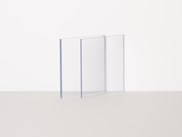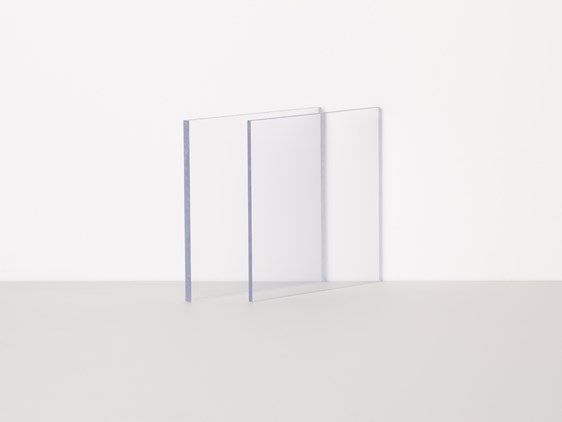Clear Polycarbonate Sheet
From £{{ (incVAT() ? initialPrice.incVAT : initialPrice.exVAT).toFixed(2) }} £{{ (incVAT() ? initialPrice.salePriceIncVAT : initialPrice.salePriceExVAT).toFixed(2) }} {{ incVAT() ? incVATTranslation : exVATTranslation }} £{{ (incVAT() ? initialPrice.incVAT : initialPrice.exVAT).toFixed(2) }} {{ incVAT() ? incVATTranslation : exVATTranslation }}
Listed below is a range of multipacks, rainbow packs (one of every available colour) and clearance items all of which are available at significantly discounted prices.

6mm - Pack of 20 (300mm x 300mm) - *** 40% DISCOUNT ***
- Thickness: 6mm
- Width: 300mm
- Height: 300mm
- Pack size: 20
Was £191.04 Was £159.20 Now £114.62 Now £95.52

8mm - Pack of 20 (300mm x 300mm) - *** 40% DISCOUNT ***
- Thickness: 8mm
- Width: 300mm
- Height: 300mm
- Pack size: 20
Was £242.16 Was £201.80 Now £145.30 Now £121.08
Bespoke Fabrication
We have the machinery and expertise to manufacture bespoke items in acrylic, polycarbonate and many other plastics, from one-offs to large production runs. Read more about the various services we offer, or complete the form below to request a quote.
CNC Routing
Our advanced Multicam Apex 3R (3 Axis) CNC routers allow us to provide an extensive range of precision CNC routing services. Read more
CNC Laser Cutting
Laser cutting is a fabrication process that uses a thin, intensely focused stream of light to cut through a range of different materials, including plastics and acrylics. Read more
Diamond & Flame polishing
Edge polishing is a fabrication process that polishes the edges of acrylic panels, removes any cutting marks, and achieves a smooth, glossy finish. Read more
Rotary & Laser Engraving
Laser engraving is a fabrication process that uses a laser beam to physically remove the surface of a material to create an indentation that is noticeable to both the eye and touch. Read more
Line Bending
Line bending is a process that’s used to make precise folds in plastic and acrylic components. Our line bending fabrication service allows us to bend plastic and acrylic sheets along a defined ‘line’ – without any need for gluing or joining. Read more
Have bespoke requirements?
Complete this form and we will get back to you with a quote.
Polycarbonate clear plastic sheet is an extremely versatile and strong material with a high resistance to impact. It's usually chosen over other forms of plastic sheeting because of its strength and resistance to impact.
Although easy to fabricate, unlike cast and extruded acrylic sheet material, the edges of polycarbonate cannot be polished.
Key features
- Impact resistance
- High strength
- Excellent optical clarity
- Hard wearing
- Weather resistant
- Lightweight
- Resistant to high temperatures (UK class 1 fire rating)
- Noise reduction/sound insulation
- Easy to cut and machine
- Recyclable
Typical applications
- Glazing
- Sky lights
- Construction
- Automotive and aircraft components
- Security components
- Signage
- Vending machines
- Street furniture
- Machine guards
- Lighting
- Roof domes
Detailed description
Impact resistance
Polycarbonate sheet has over 200 times the strength of glass while being half the weight. It's virtually unbreakable. The strength and impact resistance of the material makes it suitable for applications where safety and security is required.
Fire resistance
With an excellent UK class 1 fire rating, polycarbonate is often used in public buildings.
Weather resistant
With excellent resistance to the elements, polycarbonate sheet performs well outside. No significant changes in appearance are expected over 10 years.
Recyclable
Polycarbonate sheet is fully recyclable. The material is sorted, shredded and washed before being turned into a granulate ready for manufacturing.
Cut to Size Polycarbonate
Our cut to size service enables you to purchase Polycarbonate panels at the dimensions you require without having to purchase the manufactured sheet size, normally 3m x 2m. We do not charge for cutting standard shapes/sizes that are available on our website, however we do also offer additional options such as drilled holes, rounded corners and edge polishing. In addition to our cut to size service, we also offer more bespoke fabrication services including:
Stock sheet sizes
3050mm x 2050mm, 2050mm x 1520mm, 2440mm x 1220mm
Minimum panel size
50mm x 50mm
Maximum panel size
3050mm x 2050mm
Relative density
1.2 g/cm³
Manufacturers thickness tolerance
+/- 5% (e.g. 3mm Polycarbonate sheet could vary from 2.85mm to 3.15mm)
Cutting tolerance
+/- 1mm
Material protection
Protective film on both sides
Fire rating
UK Class 1
Service temperature
-50 to +100°c
Vicat softening temperature
150°c
Water absorption
0.15%
Recyclable
Yes
Recycled content
30%
Data sheets
We provide a fast delivery service throughout the UK using recognised Couriers such as Royal Mail, DHL, and Parcel Force.
Delivery prices are calculated based on the length of the longest side of the material ordered i.e. the delivery price of a panel measuring 1500mm x 1000mm would be based on the 1500mm dimension. Only one delivery charge is charged per order regardless of how many items are ordered.
UK Delivery costs
| Longest side | Standard Delivery | Express Delivery | Order value for FREE delivery |
|---|---|---|---|
| Samples (100mm x 100mm) | £2.95 | £9.95 | £250 |
| Less than 500mm | £6.95 | £12.95 | £250 |
| 500mm to 999mm | £9.95 | £19.95 | £250 |
| 1000mm to 1999mm | £14.95 | £24.95 | £250 |
| 2000mm or greater | £19.95 | £29.95 | £250 |
Standard delivery for all accessories is £7.95, or £12.95 for Express delivery.
All prices listed include VAT.
Delivery Times
Our guidelines for delivery times are listed below:
- Standard delivery (3-5 working days)
- Express delivery (2-3 working days)
Express Delivery
If you require faster delivery you may wish to consider choosing our Express Delivery option at the checkout. Express Delivery orders are prioritised over standard orders and delivered using a recognised nationwide courier.
Next Day Delivery
Next Day delivery is not available via our website due to the volume and bespoke nature of orders we receive on a daily basis. However, if you need to place an order and require Next Day delivery please contact us – we will make every effort to meet your requirements and deadlines.
European/EU Delivery
We have temporarily disabled European delivery for orders placed through our website whilst we make changes to ensure that the correct rate of EU VAT is being charged. Our team can however manually process orders so please contact us if you require delivery to the European Union.
Remote Areas
Due to the nature of the ”made to measure” products we supply, we provide delivery prices at a standard rate and reserve the right to cancel an order should it become economically unviable to fulfill the order. In these extremely rare circumstances, the customer will be contacted first to discuss alternative options.
When delivering to some locations we can incur increased Courier delivery costs. Should delivery be required to one of the locations listed below a remote area supplement will be automatically added to the price of delivery during the checkout process.
| Longest side | Remote area supplement |
|---|---|
| Samples (100mm x 100mm) | £0.00 |
| Less than 500mm | £0.00 |
| 500mm to 1499mm | £10.00 |
| 1500mm to 2499mm | £15.00 |
| 2500mm or greater | £20.00 |
All prices listed include VAT.
Examples of delivery locations which may incur a remote area supplement are:
- Channel Islands
- Isle of Man
- Isles of Scilly
- Isle of Wight
- Scottish Islands
- Scottish Highlands
- Remote areas of Scotland
- Northern Ireland
If you require delivery to one of these areas please get in touch to discuss your order.
Third-Party Deliveries
Some products are dispatched directly from the manufacturer and delivered by a third-party courier. If applicable, this is clearly stated on each Product page under the 'Delivery' tab/section.
Can I collect my order from Simply Plastics?
Yes, of course. Orders can be collected from our premises in Colchester, Essex. At the final stage of the checkout process there is a delivery option labelled "Collection/pickup" which is free. Once your order is complete, you will be notified by email along with our address and collection times.
I need my order urgently, can I pay for faster shipping?
Yes. We offer an express delivery service which aims to deliver all orders in 1-3 working days. Orders are delivered by a recognised courier company and may require a signature on delivery.
Do you have a minimum order charge or small order fee?
This is a question we are asked fairly regularly due to the previlance of either a minimum order charge or small order fee within the industry.
At Simply Plastics our approach has always been to treat all orders equally, small or large. We want all customers, new and existing, to be able to place orders with us confident that they are only paying for the products and materials that they require. We therefore do not have a minimum order charge or small order fee.
How can I calculate the weight of a Polycarbonate Panel?
All of the different types of plastics that are available on our website, whether they be a panel, a disc, tube or rod, show the weight of the piece you require once you have entered your dimensions, shown in grams or kg.

The weight of any plastic can be calculated using the simple formula: Weight = Volume x Density
Read our blog post on how to calculate the weight of a variety of different plastics covering panels, discs, road and tube.







 {{product.colours}} Colours
{{product.colours}} Colours








